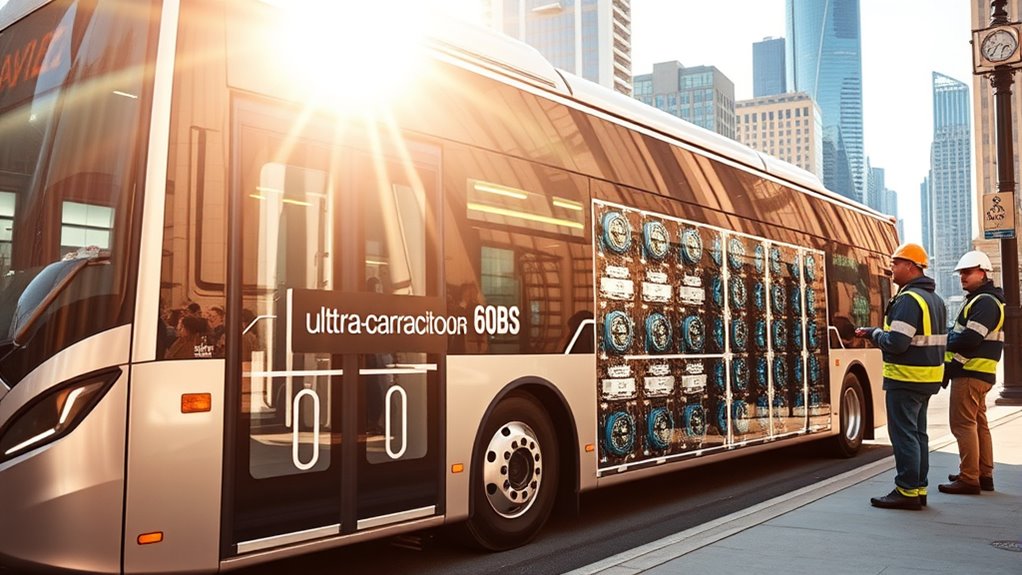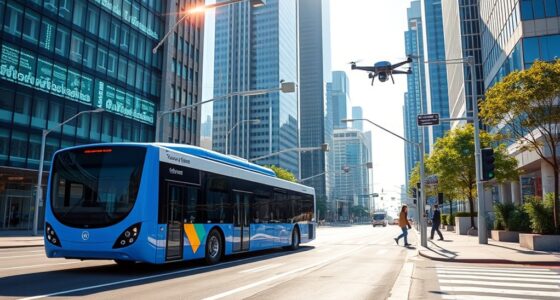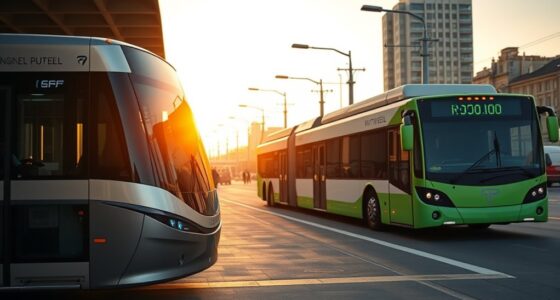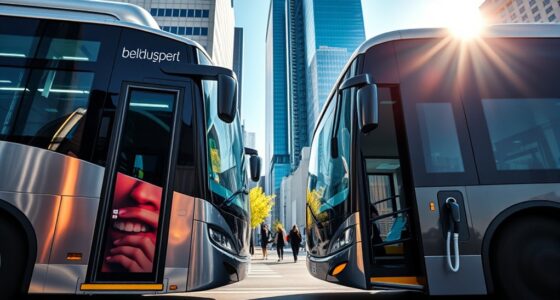Advancements in ultracapacitors are revolutionizing electric buses by enabling rapid charging, extended ranges, and improved efficiency. These devices store and discharge energy quickly, reducing downtime and emissions while supporting sustainable transit. Innovations like high power density, better thermal management, and longer lifespans make them essential for urban transportation. As these technologies evolve, they’ll further enhance energy recovery and operational flexibility. Keep exploring to discover how these developments are shaping cleaner, smarter public transit systems.
Key Takeaways
- Advances in ultracapacitor technology increase energy density and lifespan, enabling efficient use in electric buses.
- Development focuses on rapid charging systems up to 600 kW for quick turnaround times.
- Innovations include hybrid systems combining ultracapacitors with batteries for enhanced performance.
- Material improvements and pseudocapacitors boost capacity, charge cycles, and cost-effectiveness.
- Global adoption accelerates as ultracapacitors reduce emissions, lower operational costs, and support sustainable transit.
Advancements in Ultracapacitor Technology for Transit
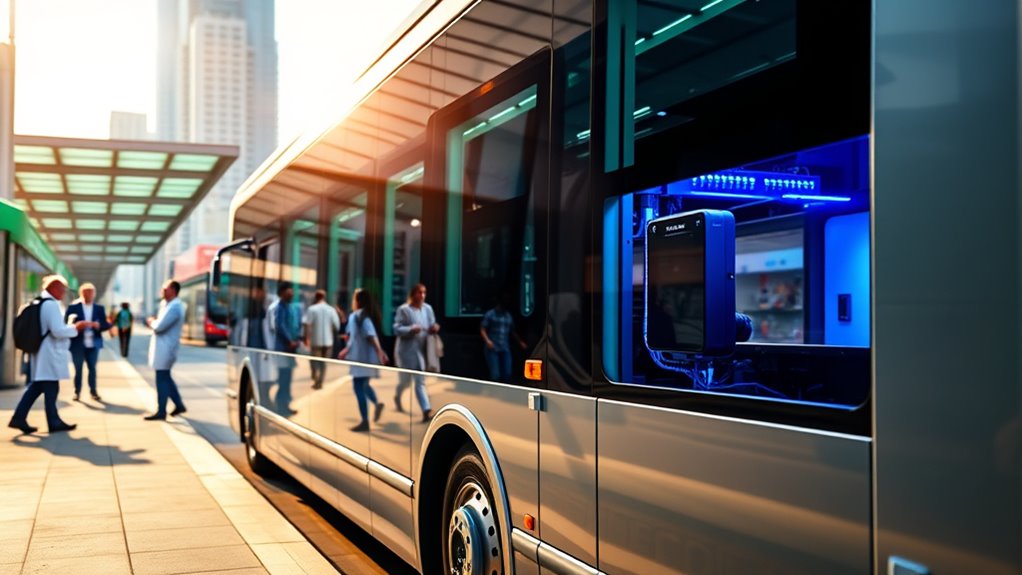
Advancements in ultracapacitor technology are transforming transit systems by providing faster, more efficient energy storage solutions. You benefit from ultracapacitors’ high power density, allowing rapid energy discharge and quick recharges that meet the acceleration needs of heavy vehicles. This technology supports frequent stop-start cycles in urban transit without performance loss.
When combined with batteries, ultracapacitors help minimize current spikes, extending battery life and reducing weight, especially with lead-acid replacements. Improvements in ESR enhance thermal management, enabling higher current loads without overheating and ensuring reliability during rapid cycling.
Modern ultracapacitors also boast increased energy density and longer lifespans, enduring over 500,000 charge cycles. These innovations facilitate integration with start-stop systems, regenerative braking, and IoT, making electric buses more efficient and responsive. Additionally, self-discovery techniques from personal development frameworks can be applied to optimize team performance and innovation in transit technology.
Environmental Advantages of Using Ultracapacitors in Public Transport
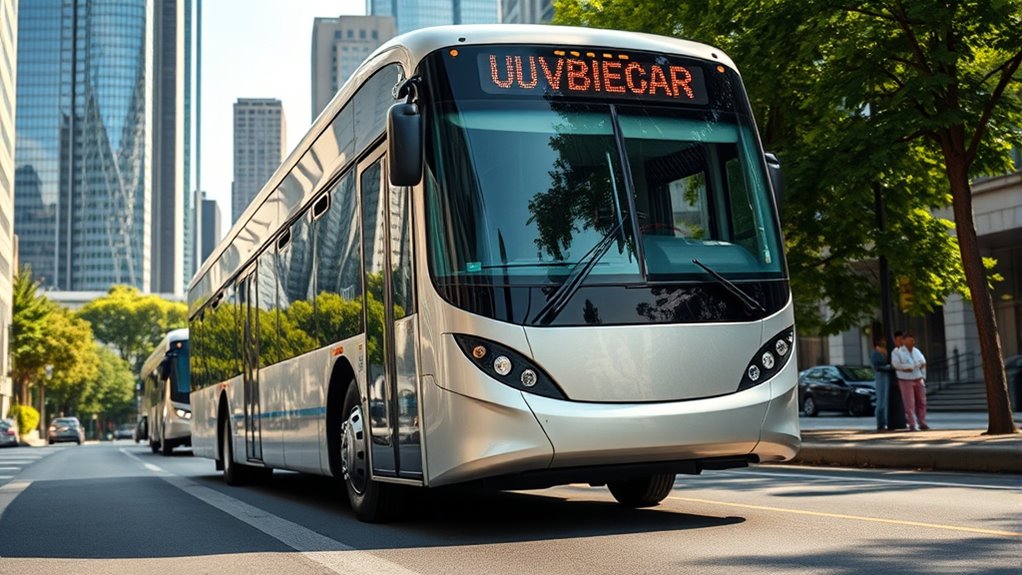
Using ultracapacitors in public transport offers significant environmental benefits by drastically reducing emissions and improving air quality. These systems lower carbon dioxide emissions substantially, producing about a third of the CO₂ compared to diesel buses, even when powered by coal.
Electric buses with ultracapacitors generate zero local emissions during operation, directly benefiting urban air quality. Hybrid buses equipped with ultracapacitors also help decrease overall greenhouse gases. Furthermore, integrating advanced energy storage technologies can optimize performance and sustainability in urban transit systems. Incorporating high-performance materials into ultracapacitor design can further enhance their environmental benefits and durability.
Additionally, ultracapacitors support sustainable energy use by enabling more efficient energy recovery during braking, reducing energy consumption by up to 40%. They contribute to lower operational costs and long-term savings while promoting cleaner, quieter urban environments. Incorporating energy-efficient materials into ultracapacitor design can further enhance their performance and environmental impact. Moreover, utilizing cost-effective energy storage solutions can make widespread adoption more feasible across urban transit networks.
Enhancing Operational Efficiency With Rapid Charging Systems

Rapid charging systems substantially enhance operational efficiency by enabling electric buses to recharge quickly and minimize downtime. With charging speeds reaching up to 600 kW, you can recharge buses in minutes, keeping your fleet on the move. These systems are compatible with various bus models and battery sizes, offering flexibility for different operations. Solutions like the Heliox Mobile 40 kW charger provide versatile, user-friendly options for both depot and on-the-go charging. High efficiency and reliability ensure your buses stay operational, reducing delays and maximizing service uptime. Additionally, scalable systems allow your fleet to grow without costly infrastructure overhauls. High efficiency and reliability are crucial factors that contribute to the effectiveness of rapid charging systems in maintaining a robust fleet. Proper planning can help avoid costly beneficiary designation errors and optimize your charging infrastructure investments. Incorporating fraud detection techniques into your management strategies can further safeguard your operations from potential risks and disruptions. To maximize benefits, it’s also essential to consider charging station availability and network connectivity to support seamless operations.
Cutting-Edge Innovations and Future Prospects in Energy Storage
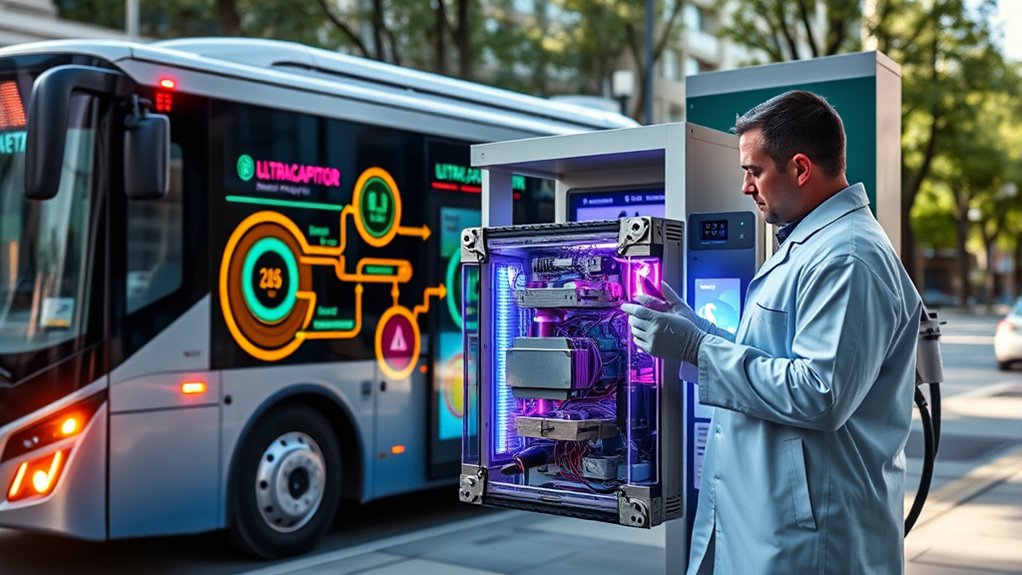
Recent breakthroughs in supercapacitor technology are transforming energy storage by increasing capacity and enhancing performance. Advances in electrode materials and electrolytes boost longevity and efficiency, while pseudocapacitors offer higher capacity through chemical reactions. Vetted developments in portable and efficient power sources are also enabling wider adoption of supercapacitors in various fields. You can now see supercapacitors integrated with batteries, creating hybrid systems that maximize both fast power delivery and energy storage. Innovation also focuses on improving power density, enabling near-instant charging and discharging with minimal energy loss, long cycle life, and compact designs. These developments support sustainability by reducing carbon footprints, promoting recyclability, and extending operational lifespan. As the market grows, supercapacitors are increasingly crucial in renewable energy systems, industrial applications, and green transportation, paving the way for more reliable, efficient, and sustainable energy storage solutions.
Global Adoption and Impact of Ultracapacitor-Powered Buses
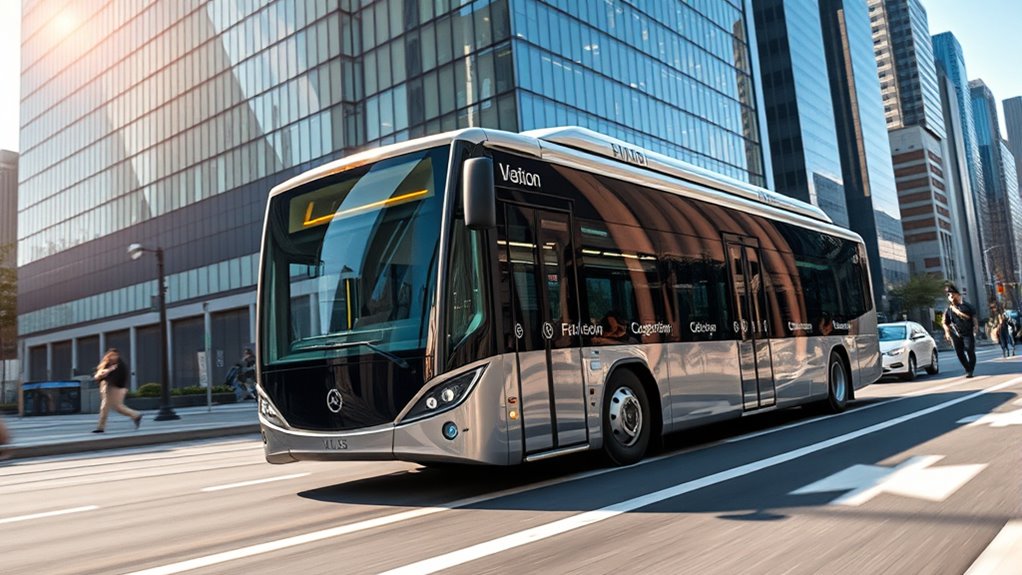
The adoption of ultracapacitor-powered buses is accelerating worldwide, driven by increasing environmental concerns and stricter government regulations. You’ll notice rapid market growth as cities seek cleaner transportation options, especially in urban areas like Los Angeles, Hamburg, and Beijing, where frequent stops benefit from ultracapacitors’ quick charging.
These buses reduce emissions and improve air quality, aligning with regional sustainability goals. Infrastructure needs are minimized since ultracapacitors charge at bus stops, lowering operational costs. Their reliability and long lifespan enhance efficiency, making them a practical choice for cities aiming to meet green policies. Additionally, advancements in energy storage technology continue to improve their performance and cost-effectiveness.
Furthermore, ongoing research into battery and capacitor materials is expected to further enhance energy density and charge cycles, supporting broader adoption. Regions like North America, Europe, and Asia are actively adopting this technology, supported by government initiatives. The development of ultracapacitor materials is particularly promising for increasing energy density and longevity, which will further expand their applications. As a result, ultracapacitor buses are transforming urban transit into a cleaner, more sustainable system worldwide. New innovations in transportation infrastructure are also facilitating this shift, making it easier for cities to implement ultracapacitor solutions.
Frequently Asked Questions
What Materials Are Used to Improve Ultracapacitor Energy Density?
You should know that improving ultracapacitor energy density involves using advanced materials like graphene, which boosts surface area and conductivity, and metal oxides, which enhance capacitance.
Carbon-based activated carbon is common, but combining it with polymers and graphene creates hybrid materials with better performance.
Upgrading electrolytes from aqueous to organic allows higher voltage operation, further increasing energy storage.
These material choices help make ultracapacitors more efficient and powerful.
How Do Ultracapacitors Compare Cost-Wise to Traditional Batteries Long-Term?
You’ll find ultracapacitors are more expensive upfront than traditional batteries, sometimes costing 275% more.
However, their longer lifespan, faster charging, and lower operating costs—up to 80% less—make them more economical over time.
They reduce energy consumption and maintenance costs, especially for city buses with frequent stops.
Though initial investment is high, the long-term savings and environmental benefits often outweigh the initial expense.
What Safety Considerations Exist for Ultracapacitor Systems in Buses?
You should know that safety considerations for ultracapacitor systems include ensuring they remain non-flammable, withstand a wide temperature range, and handle high currents safely.
You also need to monitor that there are no chemical reactions, prevent thermal runaway, and maintain system reliability.
Additionally, you must focus on integrating proper cooling, managing rapid charging, and designing for predictable operation—all vital for safe, efficient bus performance.
How Scalable Is Ultracapacitor Technology for Large Transit Fleets?
You might wonder about the scalability of ultracapacitor technology for large transit fleets. It’s highly scalable because of its high power density, rapid charging, and ability to handle thousands of start-stop cycles without degradation.
Its resilience in extreme temperatures and long lifecycle make it suitable for widespread deployment. Plus, the proven industrial applications and future market forecasts indicate ultracapacitors can efficiently support the demands of extensive transit systems.
What Challenges Remain Before Widespread Ultracapacitor Adoption?
You’re hitting the nail on the head when asking about the hurdles for widespread ultracapacitor use. The main issues include their low energy density, which means more frequent recharges and infrastructure upgrades.
High initial costs and integration with existing systems also pose challenges. Plus, durability in tough environments and standardizing charging tech are hurdles that need crossing.
Until these are addressed, broad adoption remains a distant goal.
Conclusion
You should know that ultracapacitors are transforming public transit, with some buses able to recharge in just 10-20 seconds. This rapid charging capability can increase operational efficiency and reduce emissions considerably. As more cities adopt ultracapacitor-powered buses, you’ll see cleaner air and quieter streets. The global market is expected to reach over $10 billion by 2030, showing just how impactful this technology will be for sustainable transportation.
